Many of the medals most sought after by collectors are awards for bravery. Not only are these intrinsically scarcer, they invariably provide a direct link to an act of valour which we can respect, as well as a story to research and share. Those of us whose education is based on British military history and the British military system will be very familiar with a particular way to reward bravery.
This is a system of different awards on an escalating scale depending on the level of bravery displayed, with bars to represent multiple awards, nuances of arm of service, rank (until 1993), combatant vs non-combatant etc. At its pinnacle stand the Victoria Cross and George Cross, both of which rank ahead of every other award which can be bestowed. To what extent are these basic principles followed elsewhere, and to what extent do medallic awards for bravery differ from country to country? Let’s take a little look ….
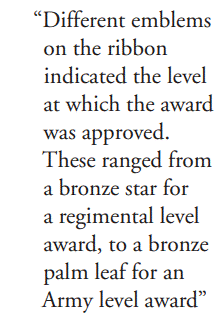
Where better to start than our closest continental neighbour, France? France has a number of awards for bravery, however there are some key differences between the French and British systems. France’s highest purely military award is the Medaille Militaire (Military Medal). A very attractive award, it was instituted by Napoleon III in 1852 as a reward for bravery or long service. However it could only be awarded to Non-Commissioned Officers and soldiers/sailors. The only time it could be awarded to a commissioned officer was if the officer in question was a general or Marshal of France who had already received the Grand Cross of the Legion of Honour, France’s highest award. Hence, this single medal could be awarded in circumstances where the British would award a bravery medal, a long service medal, or the Knight of the Garter! Interestingly, it cannot be awarded twice to the same recipient. Once you have it, that’s it.
France’s highest national award is the Legion of Honour. Founded by Napoleon Bonaparte, it is sometimes used as a bravery award, however most awards are for service to the French Republic. Sometimes these two criteria collide, as in the case of Gendarmerie Colonel Arnaud Beltrame who was posthumously made a Commander of the Legion of Honour in 2018 after he swapped places with a hostage in a terrorist related kidnapping and was tragically killed during the rescue attempt. Many French military officers killed in the line of duty were posthumously awarded the Legion of Honour since, unlike the UK, France regards death in the line of duty as the ultimate act of bravery and service to the Republic. Soldiers and NCOs killed in action are normally awarded a posthumous Medaille Militaire and most of the 1 million plus awards of that medal are posthumous, which is reflective of the huge casualties suffered by France during the First World War.
If you travel around France there is another medal that you will see on many war memorials across the country, the Croix de Guerre (War Cross). This bronze cross was instituted in 1915 as a bravery award to recognise the many and varied acts of bravery resulting from the fierce fighting in the First World War. The intent was to have an award that could be awarded without quota limits to recognise various levels of bravery.
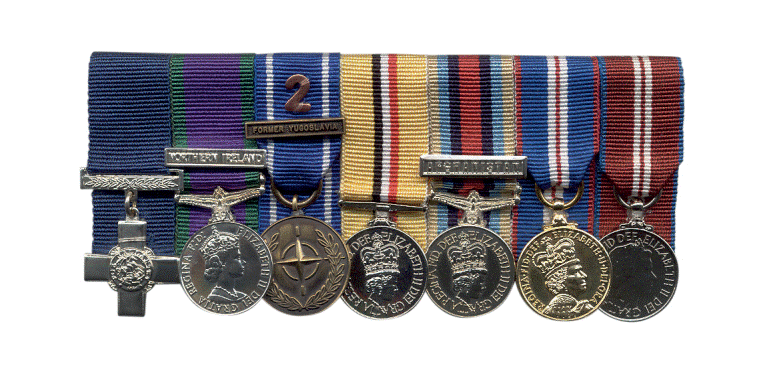
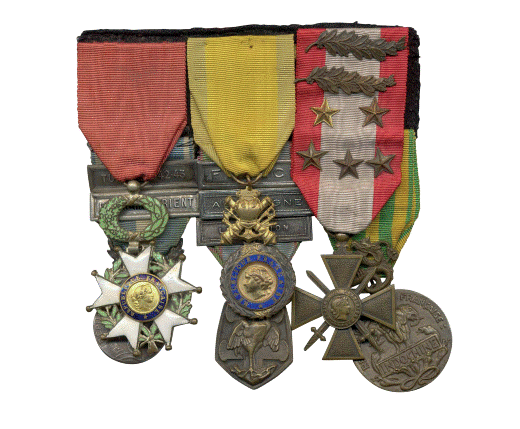
Different emblems on the ribbon indicated the level at which the award was approved. These ranged from a bronze star for a regimental level award, to a bronze palm leaf for an Army level award. In total approximately 1.2 million awards were made to French and Allied soldiers during the war.
The Croix de Guerre was disbanded after 1918 but was recreated at the outbreak of the Second World War, again as a multi-level bravery award. A version was also created in the 1920s to reward bravery in fighting outside France and this latter award is still in existence; the most recent awards are to French troops serving in Afghanistan. The Croix de Guerre is relatively low in the French order of precedence but it still occupies a highly regarded place in both popular culture and among the military.
Notwithstanding that it became an iconic symbol of military bravery in France, the Croix de Guerre was almost rejected at inception since it was thought that both the concept (a widely distributed bravery award given without consideration to the recipient’s rank) and the design (a cross) were too close to the iconic award of France’s mortal enemy, the Iron Cross. Thankfully for medal collectors its supporters were in the majority.
One of the most iconic medals in popular culture is the German Iron Cross. The design derives from the badge of the Teutonic Knights who actively fought in the Crusades during the Middle Ages. Most people believe it was created in the 20th century, however its origins go back much further. The Iron Cross was originally instituted in 1813 by Prussia as an award for bravery and distinguished leadership during the Napoleonic War. It came in a number of classes with recipients required to receive the lower classes before they could obtain a higher degree. The same award was given to everyone without distinction of rank, which was a revolutionary concept in 1813.
The award was discontinued after the end of the conflict but was reinstated in 1870, again as a Prussian award, for the Franco Prussian War. It was again reinstated by Prussia for the First World War but was widely awarded as a German level decoration to non-Prussian troops. As with previous iterations of the award, the 2nd class was suspended from a ribbon, the 1st class was a breast badge and higher classes were worn around the neck (and seldom awarded) with recipients required to earn the lower class before they were promoted though the award.
During the First World War the 2nd class was widely awarded and it became common for entire regiments to be awarded the decoration following a difficult period in the front line. Over 3.8 million Iron Cross 2nd Class awards were made for the First World War, which clearly shows how commonly it was awarded. In contrast, the 1st Class decoration was awarded 145,000.
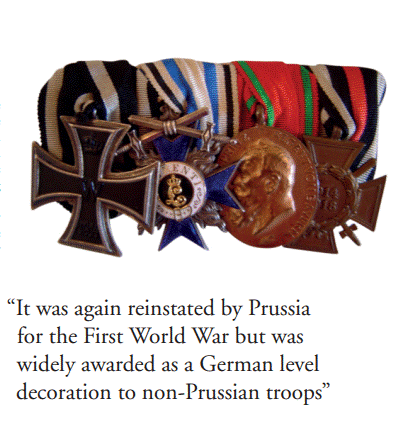
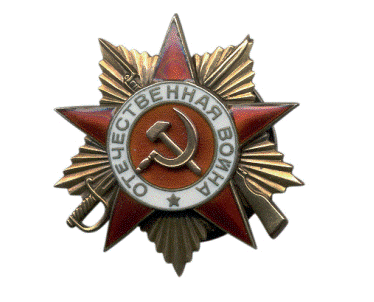
The version of the Iron Cross most commonly seen in popular culture is no doubt the Second World War version which was reinstated in 1939. The ribbon and design were changed from previous versions but the basic shape, a silver framed black cross, remained the same. It continued to be an award for bravery or distinguished leadership and the Nazi propaganda machine turned recipients of the higher classes, the Knight’s Cross (Ritterkreutz) winners, into national heroes and icons.
While Germany had a number of other bravery awards in both world wars, the Iron Cross as a multi-class award which was made to all ranks and all branches of service, without distinction, created a very flexible award, and one which got a very high degree of national recognition and respect. As in previous conflicts, the 2nd class was widely used during the Second World War to reward a level of bravery which would have remained unacknowledged under the British system. 4.5 million 2nd class awards were made from 1939-45, compared to a little over 7,300 Knight’s Cross awards. When you consider that over 13.5 million served in the German Army alone during 1939-45 it shows how rare was the Knight’s Cross. Remember that the next time you watch a Hollywood film where multiple German soldiers wear it around their necks!
Moving further east, what about Russia and the Soviet Union? Imperial Russia created the Order of St George as an award for military bravery and distinguished leadership. It came in a number of classes and was only awarded to officers. Lower ranks were awarded an associated Cross of St George, which came in four classes. Recipients first received the lowest class and then progressively worked their way up the grades with each subsequent award. This creation of a general award for bravery, albeit divided by rank, was similar to the concepts used by Germany or France and quite different to the British system.
The Soviet Union disbanded all pre Soviet Russian awards and created its own award system. While there were some awards created prior to Russia’s involvement in the Second World War, many of the Soviet awards were created after 1941. Unlike the simple system in Imperial Russia, the Soviet system created a plethora of different awards, all with very specific award criteria. The general concept of “bravery” disappeared and was replaced by an incredibly detailed and codified system. As an example, the Order of the Great Patriotic War 1st Class had 44 specific reasons why it could be awarded. These ranged from “while under enemy fire recovering no fewer than 3 damaged tanks from the battlefield” to “completing 60 successful sorties as a crew member of a fighter aircraft”. What happened if you only managed to recover 2 damaged tanks from the battlefield under enemy fire? In that case you qualified for the Order of the Great Patriotic War 2nd Class!
Unlike the British system, where subsequent awards were recognised by the use of ribbon bars, in the Soviet system subsequent awards were recognised with another full insignia. This, and the large number of post war commemorative medals, results in some very impressive chests full of colourful bling. One thing which all Soviet awards have in common is that they were very well made and well designed.
What do things look like if we continue moving east? Imperial Japan created a specific award for bravery in 1890, The Order of the Golden Kite. While its creation was influenced by Japan’s adoption of some western concepts in the late Meiji era, many of its characteristics were due to domestic Japanese culture and norms. Created in seven classes, it was only awarded to male members of the Japanese armed forces, civilians, women and Japanese allies were not eligible for it. Servicemen were eligible for three different classes of the award, depending on the rank they held. This was on a sliding scale where private soldiers were eligible for classes 7 to 5, corporals and sergeants for 6 to 4, junior officers 5 to 3, senior officers 4 to 2 and generals 3 to 1. All recipients received the lowest class for which they were eligible and were then promoted through the grades. Only the highest level awarded could be worn. The Golden Kite ranked behind the Order of the Rising Sun of the same level, as well as behind any orders of a higher level.
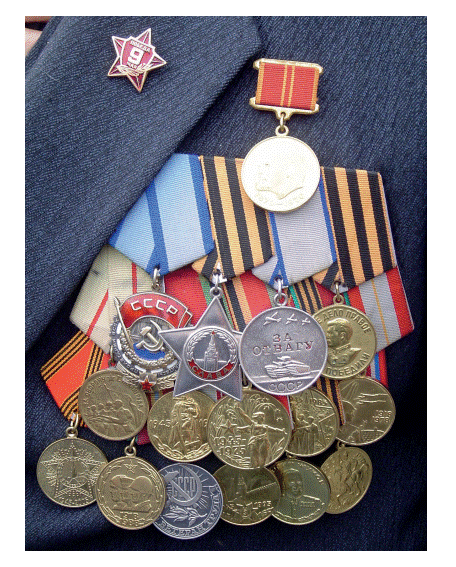
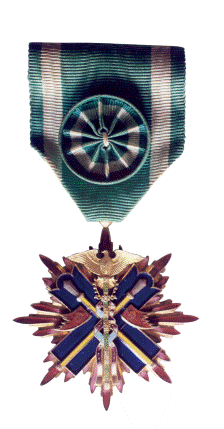
Until April 1940 the Order of the Golden Kite was awarded for bravery to both living recipients and those killed in action. Generals could receive it for distinguished leadership. It was a highly regarded award since it was bestowed in much smaller numbers than other Japanese orders, approximately 109,000 were awarded for the Russo Japanese War and about 6,000 for the First World War. It also came with an annual pension. After April 1940 the Japanese military government changed the award criteria so that it could only be awarded posthumously and the pension became a once of payment. Even this was granted in the form of a Japanese government war bond, not cash.
The military government considered it the duty of all military personnel to devote their actions to the Emperor. The wonderful British concept of “bravery above and beyond the call of duty” ceased to exist for the Japanese. The only thing worthy of recognition was death for the Emperor.
Approximately 620,000 posthumous awards were made during the Second World War, equivalent
to an award to 1 in 3 Japanese servicemen killed during the conflict. This was double the number of awards that were made cumulatively in the previous 50 years. This is why the vast majority of Golden Kite insignia which come into the collectors market are still in their lacquer case of issue, they are posthumous awards which were placed into small family house shrines by next of kin and never worn.
The world of bravery awards is vast, complex and fascinating. The examples described above only
scratch the surface of the various ways in which countries choose to recognise bravery. Hopefully
they illustrate the diverse world of medal collecting and whet the reader’s appetite to find out more. If that is the case, I am sure that Spink’s excellent Medal Department and Book Department would be very happy to help you on your collecting journey.

